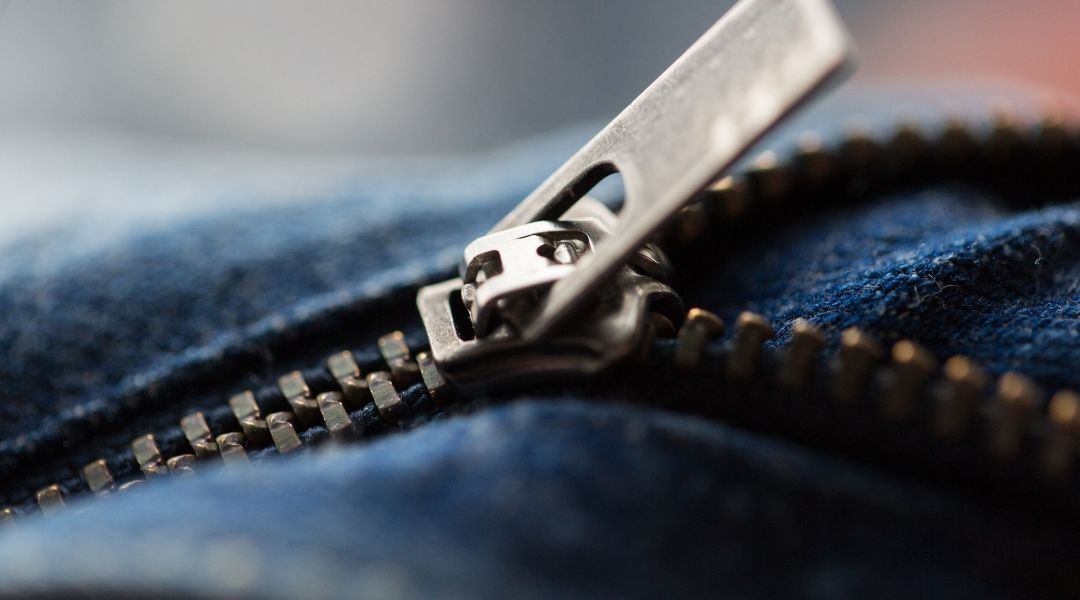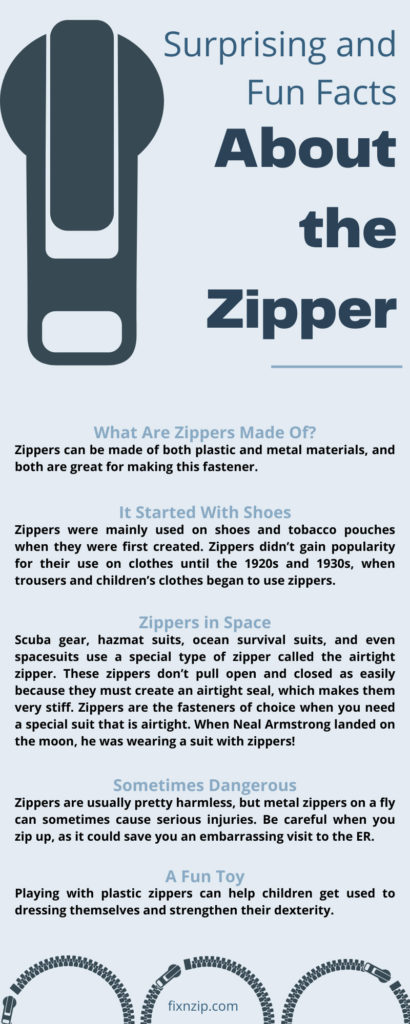
You may take the zipper on your clothes for granted, but it has a rich history of how it came to be. Learn these surprising and fun facts about the zipper and improve your trivia game.
Zippers are comprised of four elements. The “stringer” or “tape” is the cloth at either side of the zipper. The teeth are the small interlocking parts of the zipper. The zipper slider is the part which opens and closes the teeth as it slides over them. The zipper tab is the part of the zipper you use to pull the slider. Most zippers also contain a top and a bottom stop at either ends of the teeth. Zippers can be made of both plastic and metal materials, and both are great for making this fastener.
Zippers are a very versatile fastener. They’re not just on your jeans! A few uses for zippers include clothing, shoes, luggage, camping supplies, and much more.
Zippers are no joke in the business community. In the US, people utilize 4.5 billion zippers every year. That’s a lot of zippers per person!
People give credit to a few inventors for creating the zipper, but only one invention really resembles the zipper we use today. Elias Howe is sometimes credited with creating the zipper, but his invention more resembles an elaborate drawstring. Whitcomb Judson is also commonly cited as the inventor of the zipper, but his device, the clasp locker, is more of an elaborate hook-and-eye fastener. The true inventor of the zipper we know today is Gideon Sundback. Sundback’s device included teeth and a zipper slider that pulled them to a close, so he is the true inventor of what we know as a zipper. Without Gideon Sundback’s patents in 1913 and 1917, we would still be buttoning our flies closed.
The first few attempts at making zippers were all while trying to create fasteners for shoes. We don’t often think of shoes first when it comes to zippers, but they have a valuable place on your feet as well as your jeans. Zippers were mainly used on shoes and tobacco pouches when they were first created. Zippers didn’t gain popularity for their use on clothes until the 1920s and 1930s, when trousers and children’s clothes began to use zippers.
Before zippers got their name, “separable fasteners” was the name for zippers. In 1923 the B.F. Goodrich company put zippers on their goulashes and called the closure the zipper. This name, that mirrored the sound zippers make, stuck, and zippers became something we know and love.
The US Military was one of the first big customers buying zippers. They used zippers on US Navy gear in World War I, which lead to the popularization of zippers. The Navy purchased the zippers for use on windproof flying suits!
You’re going to revel in astonishment at this surprising and fun fact about zippers. Scuba gear, hazmat suits, ocean survival suits, and even spacesuits use a special type of zipper called the airtight zipper. These zippers don’t pull open and closed as easily because they must create an airtight seal, which makes them very stiff. Zippers are the fasteners of choice when you need a special suit that is airtight. When Neal Armstrong landed on the moon, he was wearing a suit with zippers!
The Rolling Stone album, Sticky Fingers, featured a photograph of jeans taken by Andy Warhol. The jeans had a working zipper and revealed underwear beneath them, also Andy’s idea. Zippers have earned their place in rock and roll and art history!
In 1954, Levi’s first used the zipper on a pair of overalls, the 501Z. It wouldn’t be until the 1970s that they would begin to use zippers on more of their jeans. Before that, the button-fly reigned supreme.
If you notice a YKK on your zipper, that stands for the Yoshida Kogyo Kabushikikaisha company. The YKK company makes more than 1.5 billion zippers a year and operates in 71 countries with 39,000 employees. Beware, though, as YKK zippers can be counterfeit.
In Outkast’s song “So Fresh and So Clean” YKK gets a shoutout from the group. This is even more evidence that zippers are important in pop culture, and not just clothes!
In the Oscar-winning film Amadeus, set in the 18th century, many of the costumes feature zippers, which wouldn’t have existed at the time. When you’re making costumes for historical films, it’s important to get all the details right.
Zippers are usually pretty harmless, but metal zippers on a fly can sometimes cause serious injuries. Be careful when you zip up, as it could save you an embarrassing visit to the ER.
Most of the world’s zippers are actually made in one place. The Qiaotou region of China produces more zippers than anywhere else in the world.
While your first thought of a zipper may be the one on your jeans, zippers can be concealed, too. Zippers are sometimes hidden under fabric, which is popular for clothing like dresses and skirts.
There are some zippers that lock into place. On a locking slider, the pull tab will only move when it’s lifted. If the pull tab is shut down, the zipper locks and can’t move. Be careful if you check to see if your zipper locks, though, as you could have one that doesn’t and wind up with a broken zipper!
Zippers aren’t only for clothes; they can also become fun activities for kids. Playing with plastic zippers can help children get used to dressing themselves and strengthen their dexterity.
Zippers break every day on clothes, but with Fix N Zip, you can replace broken parts of your zipper. Get replacement zipper sliders from Fix N Zip any time your zipper breaks.

